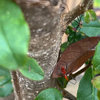Newspaper mulching Organic practice?
garotina
18 years ago
Related Stories

DESIGN PRACTICEContracting Practice: Marketing Your Business
To keep those projects rolling in, combine old-school techniques with the latest in high-tech networking
Full Story
GARDENING GUIDESNew Ways to Think About All That Mulch in the Garden
Before you go making a mountain out of a mulch hill, learn the facts about what your plants and soil really want
Full Story
GARDENING GUIDESHow to Pick a Mulch — and Why Your Soil Wants It
There's more to topdressing than shredded wood. Learn about mulch types, costs and design considerations here
Full Story
GARDENING GUIDESThe Art of Green Mulch
You can design a natural garden that doesn’t rely on covering your soil with wood and bark mulch
Full Story
GARDENING GUIDES5 Things to Know About Weeding and Mulching Your Native Garden
What’s the best time to pull weeds? How thick should the mulch be? Here’s the scoop for a healthy landscape
Full Story
NATIVE PLANTS5 Ways to Keep Your Native Plant Garden Looking Good All Year
It’s all about planning ahead, using sustainable practices and accepting plants as living organisms
Full Story
FARM YOUR YARD6 Things to Know Before You Start Growing Your Own Food
It takes time and practice, but growing edibles in the suburbs or city is possible with smart prep and patience
Full Story
LIFEHow Your Landscaping Can Keep Burglars Away
Prevent home break-ins with strategic landscaping and good practices instead of menacing — and maybe less effective — measures
Full Story
INSPIRING GARDENSFrom Concrete Lot to Gracious Organic Garden in Seattle
Plants, pests and even weeds have a place in this landscape, which offers an edible bounty and a feast for the eyes
Full Story
SHOP HOUZZShop Houzz: Focus on Organic Materials and Vintage Design
The best of the new pieces in the Houzz Shop this week
Full StoryMore Discussions







squeeze
Kimmsr
Related Professionals
Ashland Landscape Architects & Landscape Designers · North New Hyde Park Landscape Architects & Landscape Designers · Saint Louis Park Landscape Architects & Landscape Designers · Hayward Landscape Contractors · Kaysville Landscape Contractors · Mission Viejo Landscape Contractors · Olympia Landscape Contractors · Painesville Landscape Contractors · Paso Robles Landscape Contractors · Point Pleasant Landscape Contractors · Riverview Landscape Contractors · North Hills Landscape Contractors · Ferguson Landscape Contractors · Sun Lakes Decks, Patios & Outdoor Enclosures · Scotts Valley Decks, Patios & Outdoor EnclosuresgarotinaOriginal Author
mountain_curmudgeon
squeeze
paulns
led_zep_rules
Kimmsr
garotinaOriginal Author
UpstateNYgardener
cats39
albert_135 39.17°N 119.76°W 4695ft.
Tamser_windstrea_net
moonsynth_hotmail_com